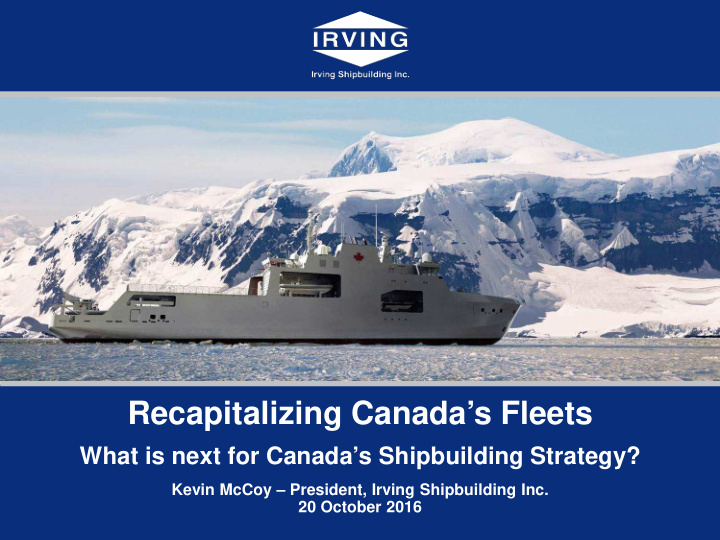



Recapitalizing Canada’s Fleets What is next for Canada’s Shipbuilding Strategy? Kevin McCoy – President, Irving Shipbuilding Inc. 20 October 2016
National Shipbuilding Strategy $520 million invested to create the best shipbuilding capability in the world + significant investment in people and processes Now that shipbuilding has been re-established on a world class level it must be maintained!
NSS: Incentivizing Investment • NSS packages awarded Oct 2011 - Competitive, transparent process - Combat vessels: Irving Shipbuilding - Non-combat vessels: SeaSpan • NSS = Industry Certainty - Up to 40 ships - 25-30 years of steady work • Leveling of boom & bust cycle • Business certainty means shipyards can confidently invest in: - Facilities - Processes - People • NSS has recapitalized and transformed the shipbuilding industry at no cost to Canada 3
NSS: Impact to Date at Irving Shipbuilding Results are already being delivered: • Over $350M invested to build the most modern shipyard in North America • More than 1,300 employees, and growing • Hiring 100-200 employees by end of 2016 • $1.1 billion in spending commitments with 200+ Canadian companies • Invested in world class training curriculum and facilities, and trained over 500 of our employees • $11 million committed for Value Proposition investments in the greater marine industry 4
Maritime Risk to Canada Canada’s Navy is being stretched compared to allies
Defence Expenditure vs. GDP Canada is not meeting NATO guidelines for defence spending and equipment investment
Naval Personnel as % of Armed Forces
Submarine Proliferation
Russia – Naval Expansion
National Shipbuilding Strategy • Once the Industrial Base is lost it takes 10 years to recreate • US builds 12-15 ships per year to support the Naval Force Structure AND maintain the Industrial Base • Five Tier 1 and Two Tier 2 Shipyards: • Aircraft Carrier - continuous build • 2 Submarines / year • 2-3 Destroyers / year • 4 Littoral Combat Ships / year • 1-2 Amphibious Ships / year • 3-4 Support Ships / year • Canada needs to keep building ships or it will lose what it has just reconstituted!!!
Current and Future Trends in Naval Warfare • Anti-submarine warfare • Bigger & better radars • Air-Sea Battle CSC role & • Proliferation of anti-ship cruise missiles spiral upgrades • Ballistic Missile Defence • Land attack/ littoral operations • Unmanned vehicles – air/surface/ submerged • Littoral operations • Modularity • Large open mission bays – adaptability • Amphibious capability AOPS • Humanitarian Assistance & Disaster Relief - Medical/ hospital MCDV replacements ? - Environmental response (oil spill, etc.) - Natural Disasters (domestic/ abroad) HA/DR ship ? - Command & Control • Constabulary capabilities Amphibious ship(s) ? - Counter drug/ terrorism/ piracy/ migrants • Smaller crews/ increased automation
The RCN Fleet – Current and Future Kingston class 970t What Next Victoria class 2,400t CSC 7,000t - 8,000t Halifax class 4,770t Harry DeWolf class 6,630t Queenston class 20,240t 2016 1990 2000 2010 2020 2030 2040 2050 2060 2070
RCN Operational Deployments Worldwide Nanook NATO NATO Westploy/ RIMPAC CP/ CT Counter Drug OEF/ Apollo HA/DR Unitas/ Caribbe UN History tells us: No shortage of missions or need to respond to crisis
Littoral Combat Ship – Fast Ship, Large Mission Bay Modularity/ Adaptability for the future
Multi Role Vessels – Standard in other Navies KNMLS Karl Doorman Joint Logistics Support Ship HMAS Canberra HMNZS Canterbury LHD Multi-Role Vessel Sealift Adaptability Crisis Response Sustainment Maritime Support Ship – For Canada?
Light Multi Role Vessel (MRV) • Flexible • Inexpensive • 3,000t – 4,000t • Shallow draught • Multi-mission configurability • Blue water/ offshore/ littoral capable • Helicopter capable • Catamaran/ trimaran? • Surface effect? • Monohull?
For a Maritime Nation with an Extensive Ocean Estate Shipbuilding is an INVESTMENT in Security and Sovereignty
To find out more about Irving Shipbuilding visit: www.ShipsforCanada.ca @IrvingShipbuild
Recommend
More recommend